The Dilemma Regarding Birch Trees
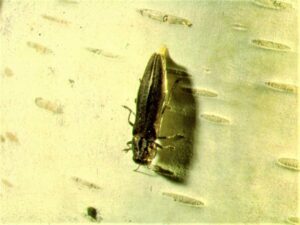
Bronze birch borer adult female laying an egg on the bark surface of a birch tree. (Photo Credit: Ohio State Coop. Ext.)
Bronze Birch Borer (Agrilus anxius) adults (440-800 GDD) are now actively searching landscapes for various species of Betula (Birch) to lay eggs upon. The adult beetles will be attracted to susceptible trees that are genetically defenseless or are compromised from stress (e.g., especially drought stress).
It is well known that the native River Birch (Betula nigra) has a strong resistance against the BBB. As a result, this species has been extensively planted in NJ landscapes during the past few decades to the extent of arguably being over-planted. And it is also widely understood that the non-native Asian & European birch species have virtually no or little resistance to the BBB. Therefore, the planting of these non-natives has rightfully been reduced over the decades. However, what about some of our other native species such as the paper, gray, & yellow birches. Is it best to avoid planting these species as well?
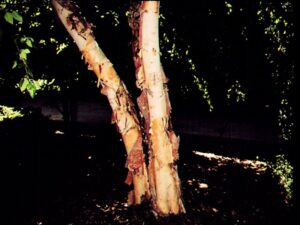
River birch (Betula nigra) is a native birch that is strongly resistant to the bronze birch borer. (Photo Credit: Steven K. Rettke, Rutgers Coop.Ext.)
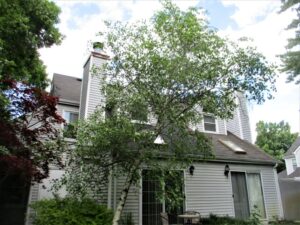
Is it best to avoid planting other native birch trees in our landscapes, such as the gray birch shown above? (Photo Credit: Steven K. Rettke, Rutgers Coop. Ext.)
Wood Borers Are the True Landscape Assassins
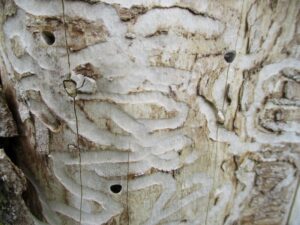
Tunnel galleries from borer larvae in the Agrilus genus can girdle the cambium & cause branch or tree death. Both the bronze birch borer & emerald ash borer (photo above) are within the Agrilus genus. (Photo Credit: Steven K. Rettke, Rutgers Coop. Ext.)
Wood-boring insects can have devastating effects on landscape plants. Although many plants are tolerant to leaf-feeding herbivores, they cannot tolerate extensive feeding within their vascular systems. For example, bronze birch borer (BBB) larvae feed within the phloem of birch and typically girdle branches or trunks. Removal of bark will show crooked, criss-crossing tunnels within the inner bark.
The resultant interference of the translocation of photosynthates (e.g., carbohydrates/starches) from the phloem to the roots results in tree starvation. Declining roots subsequently cause a reduction in the absorption of water and nutrients that results in the death of the tree with symptoms often starting at the top. The tree declines from the top-down because of hydraulic resistance. It is a myth that the bronze birch borer attacks the top of a birch tree first. This wood-boring species attacks anywhere on the tree where branches exceed 1-inch in diameter but will especially be attracted to bark wounds. Therefore, avoid making pruning cuts to birch during late spring (May/June), when adult BBB are actively laying eggs. There is only one generation per year, but individual larvae may require two years to complete their life cycle.
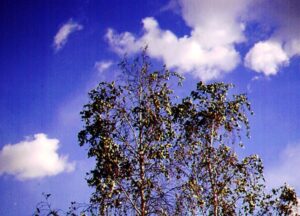
Bronze birch borer infested trees will initially show declining symptoms at the top of trees because of hydraulic resistance. (Photo Credit: Steven K. Rettke, Rutgers Coop. Ext.)
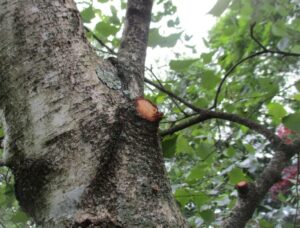
Pruning birch tress during the spring months (May & June) will create wounds that will attract egg-laying bronze birch borers. (Photo Credit: Steven K. Rettke, Rutgers Coop. Ext.)
Should White Bark Birches Be Planted?
It is commonly assumed that white bark birches should not be planted in New Jersey landscapes because of the lethal bronze birch borer. Native birch trees have evolved with the BBB and have developed powerful defenses against this woodborer. In 1979, a 20-year study was initiated @ the OARDC (Ohio Agricultural Research & Development Center) in Wooster, Ohio that attempted to determine the susceptibility of several species of white-barked birches to the BBB. In a highly replicated study, seven different birch species involved in the research were each represented by 200 trees (for a total of 1400 trees). The seven birch species included three native species (gray birch (B. populifolia), paper birch (B. papyrifera), and river birch (B. nigra)); two Asian species, (monarch birch (B. maximowicziana) and Asian white birch (B. pendula var. ‘szechwanica’)); two European species (European white birch (B. platyphylla) and mountain birch (B. pubescens)). All trees received fertilization & irrigation during the early years, but thereafter, they received no additional supplemental care.
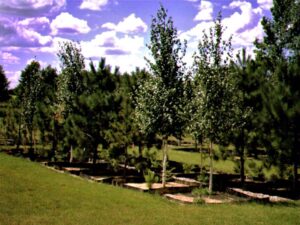
In 1979, a 20-year study was initiated @ the OARDC (Ohio Agricultural Research & Development Center) in Wooster, Ohio. The research looked at various white-barked birch species & bronze birch borer resistance. (Photo Credit: Steven K. Rettke, Rutgers Coop. Ext.)
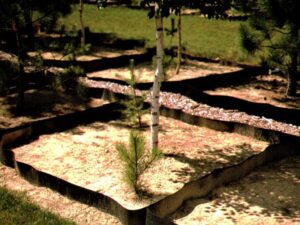
The OARDC research evaluated 7 different birch species & each species was represented by 200 trees. Three native & four non-native birch species were included in the study. (Photo Credit: Steven K. Rettke, Rutgers Coop. Ext.)
Results of the OARDC Twenty-Year Research
The three native North American birch species showed strong resistance to the BBB. The river birch is virtually immune and is rarely a host of the BBB. The native river species only exhibited 2% mortality during the 20 years. After 20 years, more than 75% of the initial 200 native paper birch species were alive and growing well in the research plots. After the 20-year study, the only birch trees left standing were the native North American species.
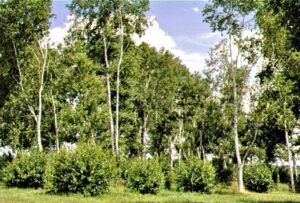
At the end of the 20-year study, the only birch trees left standing were the native North American Species. (Photo Credit: Steven K. Rettke, Rutgers Coop. Ext.)
At the other end of the spectrum, the European white, mountain, and Asian white birch species were all dead in the experimental plots in less than 10 years (all 600 trees). Virtually 100% of the tree mortality was attributed to infestations by the BBB. The monarch species fared better, but after 11-years (1990) only 10% of these trees were alive, and after 20-years (1999) they also had succumbed to the BBB. Therefore, as the study continued over the years, eventually all the nonnative birch tree species indicated a tremendous number of BBB emergence holes per square meter of bark surface.
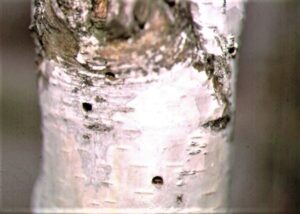
Over the years, eventually all the non-native birch tree species developed high numbers of BBB emergence holes. (Photo Credit: Steven K. Rettke, Rutgers Coop. Ext.)
Although reduced through the years, why have Asian & European white birch species continued to at least occasionally be sold & planted in our region? The perceived problem with the native birch species is that their bark does not turn white fast enough as they age. The bark of the Asian & European birches becomes white at an early age & is considered more desirable. Also, from a more cynical business perspective, the reason some nurseries continue to sell non-native Asian & European birch species is that there is a need for a lot of replacements!
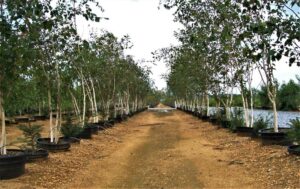
Asian & European white-bark species are still grown & available at some nurseries, despite their limited survival rates. (Photo Credit: Steven K. Rettke, Rutgers Coop. Ext.)
Native White Birches & Plant Defense Theory
Our native birches can defend themselves by several different mechanisms. The birch trees can protect themselves through the rapid accumulation of secondary metabolites (i.e., organic defensive chemicals) at the point of BBB attack. Also, protection can occur through rapid callus tissue formation (wound periderm) in areas of BBB larvae feeding. The callus formation & the phenolic compounds are therefore stimulated by the feeding wounds made by the larvae. This callus tissue is hard & dense & can crush BBB larvae as they attempt to feed within the inner bark. Furthermore, the ability to have more rapid compartmentalization of wounded trunk areas is theorized as another important defense in resistant birch trees (i.e., CODIT or Compartmentalization of Decay in Trees).
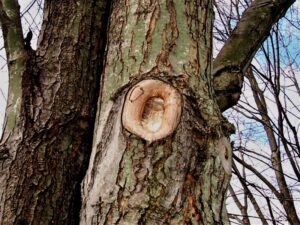
The wound periderm shown above, is callus tissue attempting to seal-over the pruning cut. This callus tissue can also crush & kill BBB larvae as they tunnel within inner bark. (Photo Credit: Steven K. Rettke, Rutgers Coop. Ext.)
Avoid Drought Stress to Maintain Resistance
The susceptibility of drought-stressed vs. well-irrigated birch trees to the bronze birch borer was also studied in the OARDC field experiments. The results of these studies indicated that the native gray and paper birch species would maintain their resistance to BBB when one inch of water per week is provided throughout the growing season. When available water was reduced to less than ½ inch per week the resistance of both birch species to the BBB was reduced significantly.
During drought conditions, the native birch trees (gray & paper species) will have reduced wound periderm growth rates. When callus tissue growth becomes less than 0.02 mm/day, then BBB resistance is greatly reduced & the % of infested trees increases exponentially.
The field experiments with the paper & gray birch species @ OARDC indicated that when these native trees received 4 or 12 inches of irrigation per year, then the percent mortality by the BBB was 100% and 75%, respectively. On the other hand, when irrigation levels approximated normal annual rainfall (i.e., 36 inches per year), then after 20 years only 25% mortality of paper birch from the BBB occurred (the gray birch mortality was even less).
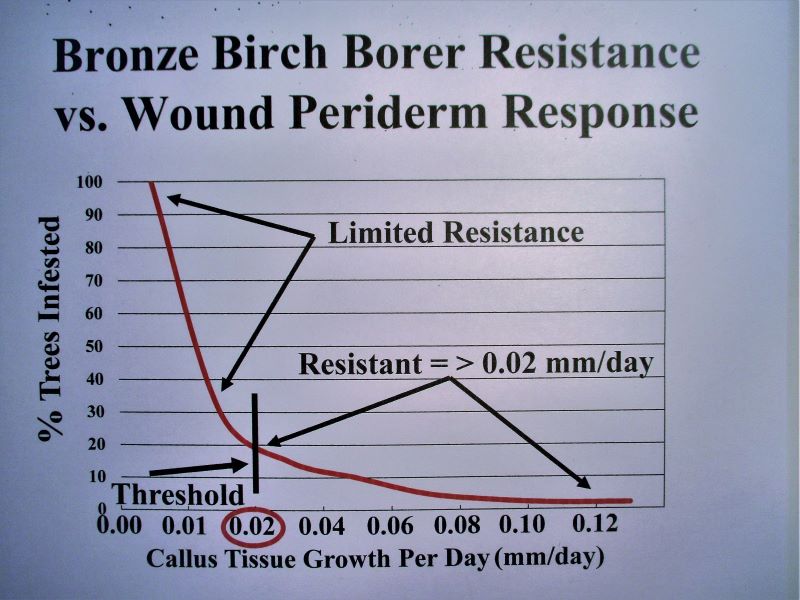
Wound periderm growth rates are highly dependant on rainfall or irrigation availability. When callus tissue growth rates become less than 0.02 mm/day, then the native gray & paper birch species will lose their resistance to the BBB. (Source: Nielsen DG & Herms DA, Ohio State University)
Summary & Conclusions:
During June, the adult bronze birch borer beetle will lay eggs on birches (i.e., primarily European white, Asian white, paper & gray birch) that are under stress (i.e., drought stress, heat stress, compacted soil, excess shade stress, etc.). The bullet-shaped, metallic black adult beetles (1/2-inch) will lay eggs on branches (>1-inch) as well as the main trunk. Monitor for adult activity & last year’s exit holes, which are shaped like the letter “D” (1/4-inch). Symptoms include initial dieback from the upper branch tips, that eventually continue down the tree. Sometimes “ripples” are noticed beneath the bark. These are raised areas caused by borer galleries as larvae pack frass & sawdust as they tunnel within the inner bark.
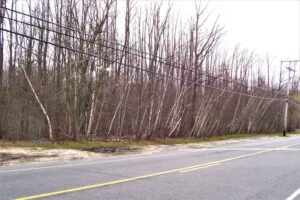
The row of gray birch trees along this road next to a wooded area must slant & grow “toward the light” in order to avoid excess shade stress. (Photo Credit: Steven K. Rettke, Rutgers Coop. Ext.)
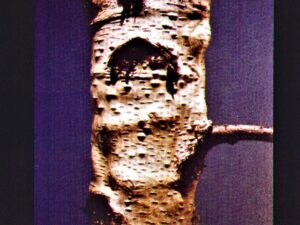
Raised surface bark areas or “ripples” on this birch indicates the presence of BBB larvae tunneling activities. (Photo Credit: Cornell University Press)
Remember, wood borers are present because the tree is already under stress. Relieve stress as much as possible by watering during drought conditions, mulching, fertilizing, controlling birch leaf miner, & pruning out dead wood (but not just before BBB adult emergence, since adults are attracted to wounds to lay eggs). Pesticide bark sprays are effective when timed to target newly hatched larvae as they chew through the bark into the tree. Pyrethroid insecticide treatments offer good preventative controls (i.e., provide a 3-week residual) if the bark is sprayed thoroughly before eggs are laid in many small cracks & crevices. Systemic insecticides (e.g., neonicotinoids) applied to the soil or as bark sprays/trunk injections offer excellent protection. BBB will often be more severe the year following a drought that occurred during the previous summer. Overall, European & Asian birch species are highly susceptible to invasion by the BBB. Our native birch trees (e.g., paper, gray, yellow) have some resistance (i.e., if not under stress) against this native wood borer. The native river birch var. ‘Heritage’ is highly resistant to the BBB.
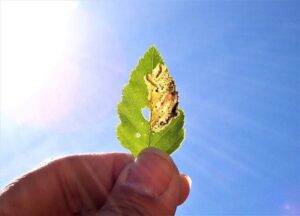
To help our native gray & paper birch species maintain good resistance to the BBB, then stresses like birch leaf miner infestations should be prevented. Fortunately, with reduced population pressures, this former NJ key insect pest is not the major health threat to birch as previously . (Photo Credit: Steven K. Rettke, Rutgers Coop. Ext.)
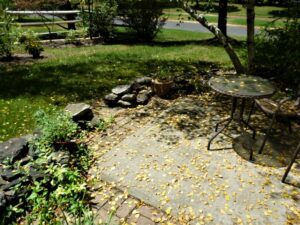
When possible, attempt to reduce drought stress on gray & paper birches. During dry summer periods, birch tress will reduce water transpiration rates by dropping leaves during mid-season. (Photo Credit: Steven K. Rettke, Rutgers Coop. Ext.)
Reference: Nielsen DG, Muilenburg VL, Herms DA (2011) Comparative resistance of Asian, European, and North American birches (Betula spp.) to bronze birch borer (Coleoptera: Buprestidae). Environmental Entomology 40:648-653
Reference: Adapted from an oral presentation by Dr. Dan Herms (Department of Entomology, Ohio State University), at the OARDC PHC Workshop, Wooster, OH – 8/99)

